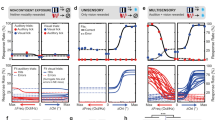Abstract
Previous research suggests that the right and left hemispheres dominate global and local perception of hierarchical patterns, respectively. The current work examined whether global perception of hierarchical stimuli requires coherent work of bilateral visual cortices using transcranial magnetic stimulation (TMS). Subjects discriminated global or local properties of compound letters in Experiment 1. Reaction times were recorded when single-pulse real TMS or sham TMS was delivered over the left or right visual cortex. While a global precedence effect (i.e., faster responses to global than local targets and stronger global-to-local interference than the reverse) was observed, TMS decreased global-to-local interference whereas increased local-to-global interference. Experiment 2 ruled out the possibility that the effects observed in Experiment 1 resulted from perceptual learning. Experiment 3 used compound shapes and observed TMS effect similar to that in Experiment 1. Moreover, TMS also slowed global RTs whereas speeded up local RTs in Experiment 3. Finally, the TMS effects observed in Experiments 1 and 3 did not differ between the conditions when TMS was applied over the left and right hemispheres. The results support a coherence hypothesis that global perception of compound stimuli depends upon the coherent work of bilateral visual cortices.
Similar content being viewed by others
References
Navon D. Forest before trees: The precedence of global features in visual perception. Cogn Psychol, 1979, 9: 353–383
Delis D, Robertson L C, Efron R. Hemispheric specialization of memory for visual hierarchical stimuli. Neuropsychologia, 1986, 24: 205–214
Lamb M R, Robertson L C, Knight R T. Attention and interference in the processing of global and local information: Effects of unilateral temporal-parietal junction lesions. Neuropsychologia, 1989, 27: 471–483
Lamb M R, Robertson L C, Knight R T. Component mechanisms underlying the processing of hierarchically organized patterns: Inferences from patients with unilateral cortical lesions. J Exp Psychol: Learn Mem Cogn, 1990, 16: 471–483
Robertson L C, Lamb M R, Knight R T. Effects of lesions of temporal-parietal junction on perceptual and attentional processing in humans. J Neurosci, 1988, 8: 3757–3769
Robertson L C, Lamb M R. Neuropsychological contributions to theories of part/whole organization. Cogn Psychol, 1991, 23: 299–330
Fink G R, Halligan P W, Marshall J C, et al. Where in the brain does visual attention select the forest and the trees? Nature, 1996, 382: 626–628
Han S, Weaver J, Murray S, et al. Hemispheric asymmetry in global/local processing: Effects of stimulus position and spatial frequency. NeuroImage, 2002, 17: 1290–1299
Walsh V, Cowey A. Transcranial magnetic stimulation and cognitive neuroscience. Nat Neurosci Rev, 2000, 1: 73–79
Sasaki Y, Hadjikhani N, Fischl B, et al. Local and global attention are mapped retinotopically in human occipital cortex. Proc Nat Acad Sci USA, 2001, 98: 2077–2082
Evans M A, Shedden J M, Hevenor S J, et al. The effect of variability of unattended information on global and local processing: Evidence for lateralization at early stages of processing. Neuropsychologia, 2000, 38: 225–239
Han S, Fan S, Chen L, et al. On the different processing of wholes and parts: A psychophysiological study. J Cogn Neurosci, 1997, 9: 686–697
Han S, Fan S, Chen L, et al. Modulation of brain activities by hierarchical processing: A high-density ERP study. Brain Topogr, 1999, 11: 171–183
Han S, He X, Woods D L. Hierarchical processing and level-repetition effect as indexed by early brain potentials. Psychophysiology, 2000, 37: 817–830
Han S, Humphreys G W. Interactions between perceptual organization based on Gestalt laws and those based on hierarchical processing. Percep Psychophys, 1999, 6: 1287–1298
Han S, Humphreys G W, Chen L. Parallel and competitive processes in hierarchical analysis: Perceptual grouping and encoding of closure. J Exp Psychol: Hum Percept Perform, 1999, 25: 1411–1432
Livingstone M, Hubel D. Segregation of form, color, movement, and depth: Anatomy, physiology, and perception. Science, 1988, 240: 740–749
Homan R W, Herman J, Purdy P. Cerebral location of international 10–20 system electrode placement. Electroencephalogr Clin Neurophysiol, 1987, 66: 376–382
Talairach J, Tournoux P. Co-planar Stereotaxic Atlas of the Human Brain. New York: Thieme, 1988
Han S, Chen L. Processing of global and local properties — An analysis with event-related brain potentials. Sci China Ser C-Life Sci, 1996, 39: 179–188
Ilmoniemi R J, Virtanen J, Ruohonen J, et al. Neuronal responses to magnetic stimulation reveal cortical reactivity and connectivity. NeuroReport, 1997, 8: 3537–3540
Roberson L C, Lamb M R, Zaidel E. Interhemispheric relations in processing hierarchical patterns: Evidence from normal and commissurotomized subjects. Neuropsychology, 1993, 7: 325–342
Weissman D H, Banich M T. Global-local interference modulated by communication between the hemispheres. J Exp Psychol: General, 1999, 8: 283–308
Han S, Humphreys G W. Segmentation and selection contribute to local processing in hierarchical analysis. Q J Exp Psychol A, 2002, 55: 5–21
Author information
Authors and Affiliations
Corresponding author
Additional information
Supported by the National Natural Science Foundation of China (Grant Nos. 30630025, 30225026, and 30328016) and the Ministry of Science and Technology of China (Grant No. 2002CCA01000)
Rights and permissions
About this article
Cite this article
Zhang, X., Han, S. Global perception depends on coherent work of bilateral visual cortices: Transcranial magnetic stimulation (TMS) studies. SCI CHINA SER C 50, 557–565 (2007). https://doi.org/10.1007/s11427-007-0067-4
Received:
Accepted:
Issue Date:
DOI: https://doi.org/10.1007/s11427-007-0067-4




